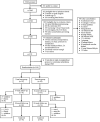Prospective randomized trial of moderately strenuous aerobic exercise after an implantable cardioverter defibrillator
- PMID: 25792557
- PMCID: PMC4447571
- DOI: 10.1161/CIRCULATIONAHA.114.014444
Prospective randomized trial of moderately strenuous aerobic exercise after an implantable cardioverter defibrillator
Abstract
Background: Despite its salutary effects on health, aerobic exercise is often avoided after receipt of an implantable cardioverter defibrillator (ICD) because of fears that exercise may provoke acute arrhythmias. We prospectively evaluated the effects of a home aerobic exercise training and maintenance program (EX) on aerobic performance, ICD shocks, and hospitalizations exclusively in ICD recipients.
Methods and results: A total of 160 patients (124 men and 36 women) were randomly assigned who had an ICD for primary (43%) or secondary (57%) prevention to EX or usual care (UC). The primary outcome was peak oxygen consumption, measured with cardiopulmonary exercise testing at baseline and 8 and 24 weeks. EX consisted of 8 weeks of home walking for 1 h/d, 5 d/wk at 60% to 80% of heart rate reserve, followed by 16 weeks of maintenance home walking for 150 min/wk. Adherence to EX was determined from exercise logs, ambulatory heart rate recordings of exercise, and weekly telephone contacts. Patients assigned to UC received no exercise directives and were monitored by monthly telephone contact. Adverse events were identified by ICD interrogations, patient reports, and medical charts. ICD recipients averaged 55±12 years and mean ejection fraction of 40.6±15.7; all were taking β-blocker medications. EX significantly increased peak oxygen consumption (EX, 26.7±7.0 mL/kg per minute; UC, 23.9±6.6 mL/kg per minute; P=0.002) at 8 weeks, which persisted during maintenance exercise at 24 weeks (EX, 26.9±7.7 mL/kg per minute; UC, 23.4±6.0 mL/kg per minute; P<0.001). ICD shocks were infrequent (EX=4 versus UC=8), with no differences in hospitalizations or deaths between groups.
Conclusions: Prescribed home exercise is safe and significantly improves cardiovascular performance in ICD recipients without causing shocks or hospitalizations.
Clinical trial registration: URL: http://www.clinicaltrials.gov. Unique identifier: NCT00522340.
Keywords: arrhythmias, cardiac; defibrillators, implantable; exercise; heart arrest; heart rate.
© 2015 American Heart Association, Inc.
Figures
Comment in
-
Letter by Ayoub Regarding Article, "Prospective Randomized Trial of Moderately Strenuous Aerobic Exercise After an Implantable Cardioverter Defibrillator".Circulation. 2015 Dec 15;132(24):e380. doi: 10.1161/CIRCULATIONAHA.115.017955. Circulation. 2015. PMID: 26667102 No abstract available.
-
Response to Letter Regarding Article, "Prospective Randomized Trial of Moderately Strenuous Aerobic Exercise After an Implantable Cardioverter Defibrillator".Circulation. 2015 Dec 15;132(24):e381. doi: 10.1161/CIRCULATIONAHA.115.018778. Circulation. 2015. PMID: 26667103 Free PMC article. No abstract available.
References
-
- Kurtz SM, Ochoa JA, Lau E, Shkolnikov Y, Pavri BB, Frisch D, Greenspon AJ. Implantation trends and participant profiles for pacemakers and implantable cardioverter defibrillators in the United States:1993-2006. Pacing Clin Electrophysiol. 201033:705–711. - PubMed
-
- Cutitta KE, Woodrow LK, Ford J, Shea J, Fischer A, Hazelton G, Sears SF. Shocktivity: ability and avoidance of daily activity behaviors in ICD patients. J Cardiopulm Rehabil Prev. 2014:241–7. - PubMed
-
- Van Ittersom M, de Greef M, can Gelder I, Coster J, Brugemann J, van der Schans C. Fear of exercise and health related quality of life in participants with an ICD. Intern J Rehab Res. 2003;26:117–122. - PubMed


